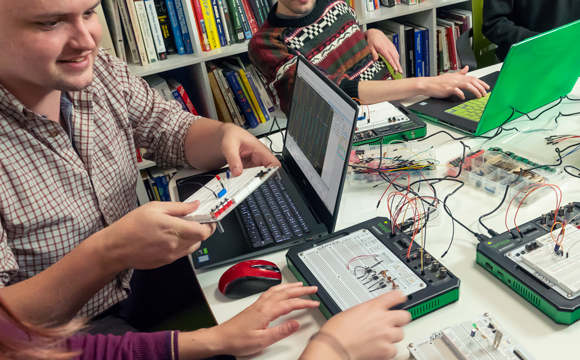If you’re stuck in the unfamiliar situation of attempting to complete the rest of this semester’s EE courses online (rather than in your lab), read on. We want to make sure you feel confident and empowered that using Digilent products will make this transition much easier for you.
First things first, you are not alone. Professors at UMass Lowell, Columbia, Texas A&M, Southeast University (China), and 70 other universities around the world have already successfully implemented curricula based around the Analog Discovery 3 and Analog Discovery Studio.
UMass Lowell adopted a “laboratory anywhere” teaching model, converting half of the lab sessions into Analog Discovery 3 labs – where the students work on their own and have half of the laboratory time. However, due to recent school closures, they have moved to an entirely online effort. They found that students in the Analog Discovery 3 based labs were more engaged, better laboratory scores, and saw an increase of 2% in final grades with no negative impact.
At Montana State University, Professor Brock LaMeres uses the Analog Discovery 3 as the test and measurement solution for digital electronics courses, allowing him to teach them 100% remotely. He says, “The Analog Discovery 3 is the key enabler for conducting our circuits labs remotely. It allows students to power their breadboards and take measurements just as if they were physically at a lab bench on campus. In many cases, it surpasses the functionality that we provide to the students in the physical lab. Our students now get experience with logic analysis and driving digital signals into their circuits. But, what makes the Analog Discovery 3 practical is its cost. Academic pricing makes it feasible for our department to purchase and distribute devices to each student. That isn’t possible with some of the more expense portable lab instruments on the market.”
The paper “Active Learning: Improving Student Learning using Portable Computer-Based-Test-Equipment,” Dr. Mihaela Radu and Dr. Mircea Dabacan discuss the use of the Analog Discovery from Digilent as a means of increasing experiential learning for engineering students, and proves with results that this approach works.

Resources For You
So, excellent – you now know that Digilent can help salvage your semester. But how do you implement it? With an Analog Discovery 3 shipped to every student, they will have the tools they need to succeed but what about transitioning material? Hop on over to our Resource Center where you’ll find an abundance of resources for you and your students. Device specific resources to help students include tutorials for each of the instruments a getting started guide, and more. The free course Intro to Analog Circuits Using the Analog Discovery 3, with optional physical textbook Real Analog textbook (sold on Amazon, and made compatible for Analog Discovery 3!). This is an entire course (that you can pick and choose from), broken down by chapters including text material and labs. Feel free to use all of these resources to help transition your course to online, and of course if you are your students have any questions they can head over to the Digilent Forum.
What Do Students Say About It?
- “I am an Electrical Engineering student and can say hands down this is the most versatile and useful tool I own. If the Analog Discovery 3 had only the network analyzer it would still be worth the money. I am one of few students at my school that can test the frequency response of the circuits I create from home. The network analyzer is very useful when creating filter circuits, especially when the filters are tunable and I need to dial them in. ”
- “One of my instructors recommended the Analog Discovery 3 for our lab assignments, and I opted not to buy one (trying to save money.) My lab partner had one, so we used his. On the first lab assignment, after seeing all the things it could do I decided to buy one.”
- “If you are an electrical engineering student, this is an absolute must have. Practical enough to be portable but as powerful as any instrumentation system you’ll ever need. I have mostly used the oscilloscopes, wave generators and power supplies, they work seamlessly. I love how easy the software is for controlling the Analog Discovery. Its a buy you don’t have to think twice.”
- “This thing is awesome. I have only had a chance to use the oscilloscope and the digital analyzer but they have worked great. The software is awesome as well. It suits my needs for school great!”
- “It’s all the things stated above. In my lab courses I’m so used to everything being much bigger. Although these don’t have the same capabilities as the bigger, clunkier, more expensive machines, these are really cool especially for a learner like me.”
- “I am a second year electrical engineering student and got this item recommended by a friend while I was looking for an oscilloscope. If you are reading this review and you too are looking for a oscilloscope, don’t search anymore. This is the EE swiss knife you need.”


I’ve not moved my course online yet, but my textbook
https://leanpub.com/applied_analog_electronics also uses the Analog Discovery 2.
The textbook is only $6 (PDF), and I’ll give a free coupon to any instructor who wants to consider the book for a course, either as the main text or a suplement.
The course is a first course in electronics (only prereq is differential calculus), and emphasizes design rather than analyzing circuits. The three main concepts, used over and over, are voltage dividers, complex impedance, and negative-feedback amplifiers.
That’s awesome, Kevin! Thanks for sharing that with us. We’ll post that link on our Twitter!